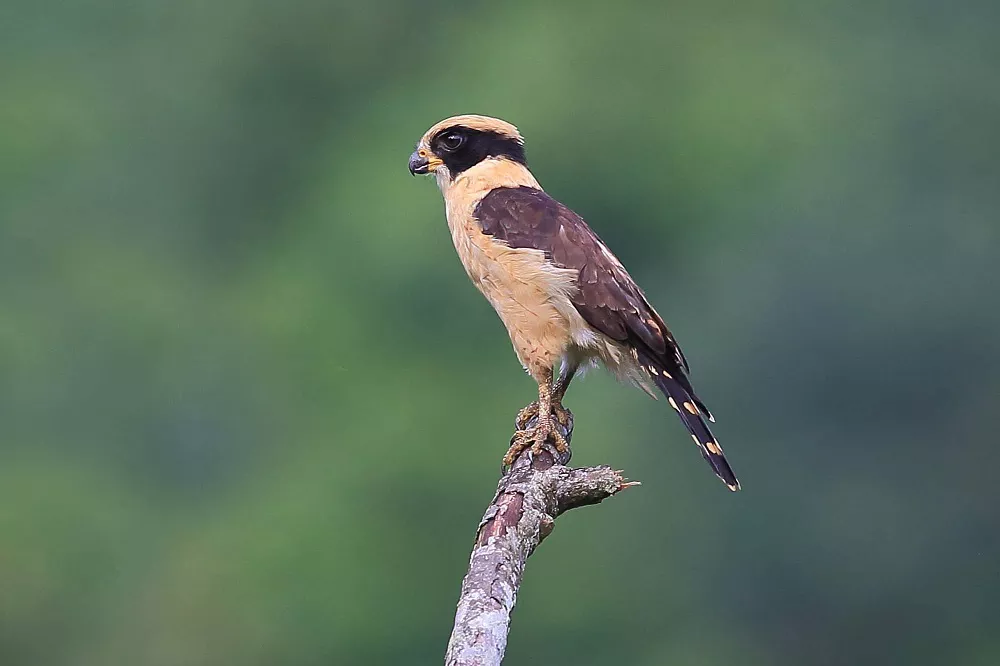In the tropical forests of Central and South America, a unique and captivating sound can often be heard piercing through the dense foliage. This unmistakable call belongs to the Laughing Falcon (Herpetotheres cachinnans), a bird renowned for its vocal talents and its ability to mimic sounds from its surroundings. In this article, we explore the enchanting vocalizations of the Laughing Falcon, delving into its distinctive “laugh-like” call and its significance in the avian world.
Description and Habitat
The Laughing Falcon is a medium-sized raptor that primarily inhabits the lowland forests, tropical rainforests, and savannas of Central and South America. It showcases a stunning combination of colors, featuring a reddish-brown back, white underparts with dark streaks, and a distinctive black mask around its eyes. Its unique appearance is complemented by a vocal repertoire that has earned it its fitting name.
The Laughing Falcon’s Call: Hauntingly Human-like
The laughing falcon’s call is a series of staccato notes that sound very much like a human chuckle or laugh. The call begins with a low growl or grumble, followed by a rapid series of “kak kak kak” sounds that increase in speed and volume. The final notes of the call are usually the loudest and most intense, almost like a cackle.
Interestingly, not all laughing falcons sound exactly alike. Each individual bird has its own unique vocalization, with variations in pitch, tone, and rhythm. Moreover, the call of a laughing falcon can vary depending on the situation. For example, when the bird is courting a mate or defending its territory, its call may be longer and more elaborate than when it is simply communicating with other falcons.
Communicative and Territorial Significance
The Laughing Falcon’s vocalizations serve several important purposes, including communication, territorial defense, and courtship displays.
Communication: The Laughing Falcon uses its unique call to communicate with its mate or establish contact with other individuals within its territory. It is believed that the call helps maintain pair bonds and coordinate activities within the bird’s habitat.
Territorial Defense: The distinct call of the Laughing Falcon plays a crucial role in territorial defense. By vocalizing loudly and repeatedly, the bird asserts its presence and warns potential intruders to stay away from its territory.
Courtship Display: During the breeding season, the Laughing Falcon’s vocalizations take on an additional significance. The male utilizes its call as part of an elaborate courtship display to attract a female. The performance includes the display of wings, rapid head movements, and, of course, the resounding laugh-like calls.
How the Laughing Falcon Makes Its Calls
So, how does the laughing falcon create such a human-like call? The answer lies in the bird’s specialized syrinx, which is the vocal organ found in most birds. Unlike other raptors, laughing falcons have a double-notched syrinx, which allows them to produce two separate tones simultaneously.
When the laughing falcon makes its calls, it produces two independent streams of air that pass through the syrinx and vibrate the membranes. By varying the tension and positioning of the membranes, the bird can create different tones and rhythms, resulting in its unique vocalizations.
Mimicry Abilities of the Laughing Falcon
In addition to its unique laugh-like call, the Laughing Falcon possesses exceptional mimicry abilities. It can imitate a range of sounds, including the vocalizations of other bird species, animals, and even mechanical sounds. This mimicry may serve as a means of camouflage, allowing the Laughing Falcon to blend into its surroundings or deceive potential threats or prey.
Conservation Status and Threats
Although the laughing falcon is not considered endangered, it does face threats from habitat loss, deforestation, and hunting. The bird’s reliance on forested habitats makes it particularly vulnerable to habitat destruction and fragmentation. In addition, the use of pesticides and other toxins can harm the bird’s prey, reducing the availability of food resources.
Conclusion:
The Laughing Falcon’s vocalizations captivate bird enthusiasts and researchers alike. Its distinctive laugh-like call resonates through the tropical forests of Central and South America, conveying messages of communication, territorial defense, and courtship. The ability to mimic various sounds adds to its allure and highlights the exceptional vocal repertoire of this fascinating raptor. The haunting call of the Laughing Falcon serves as a reminder of the rich diversity of vocal expressions found in the avian world, inspiring further exploration and appreciation of our feathered companions in nature.
Related topics:


 Facebook
Facebook  Instagram
Instagram  Youtube
Youtube 